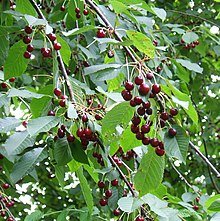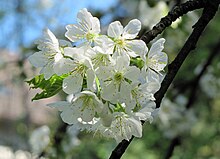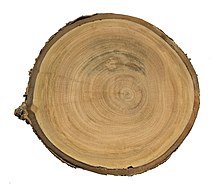Prunus avium
| Prunus avium | |
|---|---|

| |
| Scientific classification | |
| Kingdom: | Plantae |
| Clade: | Tracheophytes |
| Clade: | Angiosperms |
| Clade: | Eudicots |
| Clade: | Rosids |
| Order: | Rosales |
| Family: | Rosaceae |
| Genus: | Prunus |
| Subgenus: | Prunus subg. Cerasus |
| Section: | P. sect. Cerasus |
| Species: | P. avium
|
| Binomial name | |
| Prunus avium | |

| |
| Distribution map | |
| Synonyms[2] | |
Prunus avium, commonly called wild cherry,[3] sweet cherry [3] or gean [3] is a species of cherry, a flowering plant in the rose family, Rosaceae. It is native to Europe, Anatolia, Maghreb, and Western Asia, from the British Isles[4] south to Morocco and Tunisia, north to the Trondheimsfjord region in Norway and east to the Caucasus and northern Iran, with a small isolated population in the western Himalaya.[5] The species is widely cultivated in other regions and has become naturalized in North America, New Zealand and Australia.[6][7][8]
Prunus avium has a diploid set of sixteen chromosomes (2n = 16).[9] All parts of the plant except for the ripe fruit are slightly toxic, containing cyanogenic glycosides.
Description[edit]

Prunus avium is a deciduous tree growing to 5–18 metres (16–59 feet) tall, with a trunk up to 1.5 m (5 ft) in diameter. Young trees show strong apical dominance with a straight trunk and symmetrical conical crown, becoming rounded to irregular on old trees.[citation needed]
- The bark is smooth purplish-brown with prominent horizontal grey-brown lenticels on young trees, becoming thick dark blackish-brown and fissured on old trees.
- The leaves are alternate, simple ovoid-acute, 7–14 centimetres (2+3⁄4–5+1⁄2 inches) long and 4–7 cm (1+1⁄2–2+3⁄4 in) broad, glabrous matt or sub-shiny green above, variably finely downy beneath, with a serrated margin and an acuminate tip, with a green or reddish petiole 2–3.5 cm (3⁄4–1+1⁄2 in) long bearing two to five small red glands. The tip of each serrated edge of the leaves also bear small red glands.[10] In autumn, the leaves turn orange, pink or red before falling.
- The flowers are produced in early spring at the same time as the new leaves, borne in corymbs of two to six together, each flower pendent on a 2–5 cm (3⁄4–2 in) peduncle, 2.5–3.5 cm (1–1+1⁄2 in) in diameter, with five pure white petals, yellowish stamens, and a superior ovary; they are hermaphroditic, and pollinated by bees. The ovary contains two ovules, only one of which becomes the seed.[11]
- The fruit is a drupe 1–2 cm (1⁄2–3⁄4 in) in diameter (larger in some cultivated selections), bright red to dark purple when mature in midsummer, edible, variably sweet to somewhat astringent and bitter to eat fresh. Each fruit contains a single hard-shelled stone 8–12 mm long, 7–10 mm wide and 6–8 mm thick, grooved along the flattest edge; the seed (kernel) inside the stone is 6–8 mm long.

Taxonomy[edit]

The early history of its classification is somewhat confused. In the first edition of Species Plantarum (1753), Linnaeus treated it as only a variety, Prunus cerasus var. avium, citing Gaspard Bauhin's Pinax theatri botanici (1596).[citation needed]
His description, Cerasus racemosa hortensis ("cherry with racemes, of gardens")[clarification needed] shows it was described from a cultivated plant.[12] Linnaeus then changed from a variety to a species Prunus avium in the second edition of his Flora Suecica in 1755.[13]
Sweet cherry was known historically as gean or mazzard (also 'massard'). Until recently, both were largely obsolete names in modern English.[citation needed]
The name "wild cherry" is also commonly applied to other species of Prunus growing in their native habitats, particularly to the North American species Prunus serotina.[citation needed]
Prunus avium means "bird cherry" in the Latin language,[5] but in English "bird cherry" refers to Prunus padus.[14]
Mazzard[edit]
'Mazzard' has been used to refer to a selected self-fertile cultivar that comes true from seed, and which is used as a seedling rootstock for fruiting cultivars.[15][16] The term is used particularly for the varieties of P. avium grown in North Devon and cultivated there, particularly in the British orchards at Landkey.[citation needed]
Ecology[edit]
The fruit are readily eaten by numerous kinds of birds and mammals, which digest the fruit flesh and disperse the seeds in their droppings. Some rodents, and a few birds (notably the hawfinch), also crack open the stones to eat the kernel inside.[citation needed]
The leaves provide food for some animals, including Lepidoptera such as the case-bearer moth Coleophora anatipennella.[citation needed]
The tree exudes a gum from wounds in the bark, by which it seals the wounds to exclude insects and fungal infections.[17]
Prunus avium is thought to be one of the parent species of Prunus cerasus (sour cherry), by way of ancient crosses between it and Prunus fruticosa (dwarf cherry) in the areas where the two species overlap. All three species can breed with one another. Prunus cerasus is now a species in its own right, having developed beyond a hybrid and stabilised.[18]
Cultivation[edit]
It is often cultivated as a flowering tree. Because of the size of the tree, it is often used in parkland, and less often as a street or garden tree. The double-flowered form, 'Plena', is commonly found, rather than the wild single-flowered forms.[19] In the UK, P. avium 'Plena' has gained the Royal Horticultural Society's Award of Garden Merit.[20][21]
Two interspecific hybrids, P. × schmittii (P. avium × P. canescens) and P. × fontenesiana (P. avium × P. mahaleb) are also grown as ornamental trees.[19]
Toxicity[edit]
All parts of the plant except for the ripe fruit are slightly toxic, containing cyanogenic glycosides.[22][23][24]
Uses[edit]
Fruit[edit]

Some 18th- and 19th-century botanical authors[who?] assumed a western Asian origin for the species based on the writings of Pliny; however, archaeological finds of seeds from prehistoric Europe contradict this view.[citation needed]
Wild cherries have been an item of human food for several thousands of years. The stones have been found in deposits at Bronze Age settlements throughout Europe, including in Britain.[15] In one dated example, wild cherry macrofossils were found in a core sample from the detritus beneath a dwelling at an Early and Middle Bronze Age pile-dwelling site on and in the shore of a former lake at Desenzano del Garda or Lonato, near the southern shore of Lake Garda, Italy. The date is estimated at Early Bronze Age IA, carbon dated there to 2077 BCE plus or minus 10 years. The natural forest was largely cleared at that time.[25]
By 800 BCE, cherries were being actively cultivated in Asia Minor, and soon after in Greece.[15]
As the main ancestor of the cultivated cherry, the sweet cherry is one of the two cherry species which supply most of the world's commercial cultivars of edible cherry (the other is the sour cherry Prunus cerasus, mainly used for cooking; a few other species have had a very small input).[15]
Various cherry cultivars are now grown worldwide wherever the climate is suitable; the number of cultivars is now very large.[15] The species has also escaped from cultivation and become naturalised in some temperate regions, including southwestern Canada, Japan, New Zealand, and the northeast and northwest of the United States.[5]
Timber[edit]
The hard, reddish-brown wood (cherry wood) is valued as a hardwood for woodturning, and making cabinets and musical instruments.[17] Cherry wood is also used for smoking foods, particularly meats, in North America, as it lends a distinct and pleasant flavor to the product.[citation needed]
Other uses[edit]

The gum from bark wounds is aromatic and can be chewed as a substitute for chewing gum. Medicine can be prepared from the stalks (peduncles) of the drupes that is astringent, antitussive, and diuretic.[16]
A green dye can also be prepared from the plant.[16]
Wild cherry is used extensively in Europe for the afforestation of agricultural land and it is also valued for wildlife and amenity plantings. Many European countries have gene conservation and/or breeding programmes for wild cherry.[26]
Cultural history[edit]
Pliny distinguishes between Prunus, the plum fruit,[27] and Cerasus, the cherry fruit.[28] Already in Pliny quite a number of cultivars are cited, some possibly species or varieties, Aproniana, Lutatia, Caeciliana, and so on. Pliny grades them by flavour, including dulcis ("sweet") and acer ("sharp").[29] and goes so far as to say that before the Roman consul Lucius Licinius Lucullus defeated Mithridates in 74 BC, Cerasia … non-fuere in Italia, "There were no cherry trees in Italy". According to him, Lucullus brought them in from Pontus and in the 120 years since that time they had spread across Europe to Britain.[28]
Although cultivated/domesticated varieties of Prunus avium (sweet cherry) did not exist in Britain or much of Europe, the tree in its wild state is native to most of Europe, including Britain. Evidence of consumption of the wild fruits has been found as far back as the Bronze Age at a Crannog in County Offaly, in Ireland.[30]
Seeds of a number of cherry species have however been found in Bronze Age and Roman archaeological sites throughout Europe. The reference to "sweet" and "sour" supports the modern view that "sweet" was Prunus avium; there are no other candidates among the cherries found. In 1882 Alphonse de Candolle pointed out that seeds of Prunus avium were found in the Terramare culture of north Italy (1500–1100 BC) and over the layers of the Swiss pile dwellings.[31] Of Pliny's statement he says (p. 210):
Since this error is perpetuated by its incessant repetition in classical schools, it must once more be said that cherry trees (at least the bird cherry) existed in Italy before Lucullus, and that the famous gourmet did not need to go far to seek the species with the sour or bitter fruit.
De Candolle suggests that what Lucullus brought back was a particular cultivar of Prunus avium from the Caucasus. The origin of cultivars of P. avium is still an open question. Modern cultivated cherries differ from wild ones in having larger fruit, 2–3 cm diameter. The trees are often grown on dwarfing rootstocks to keep them smaller for easier harvesting.[32]
Folkard (1892) similarly identifies Lucullus's cherry as a cultivated variety. He states that it was planted in Britain a century after its introduction into Italy, but "disappeared during the Saxon period". He notes that in the fifteenth century "Cherries on the ryse" (i.e. on the twigs) was one of the street cries of London, but conjectures that these were the fruit of "the native wild Cherry, or Gean-tree". The cultivated variety was reintroduced into Britain by the fruiterer of Henry VIII, who brought it from Flanders and planted a cherry orchard at Teynham.[33]
See also[edit]
References[edit]
- ^ Rivers, M.C. (2017). "Prunus avium". IUCN Red List of Threatened Species. 2017: e.T172064A50673544. doi:10.2305/IUCN.UK.2017-3.RLTS.T172064A50673544.en. Retrieved 19 November 2021.
- ^ "Prunus avium L." Plants of the World Online. Royal Botanic Gardens, Kew. Retrieved 17 March 2024.
- ^ a b c "Prunus avium". Germplasm Resources Information Network. Agricultural Research Service, United States Department of Agriculture. Retrieved 11 December 2017.
- ^ British Trees Online Archived 3 September 2000 at the Wayback Machine
- ^ a b c Den Virtuella Floran: Prunus avium (in Swedish; with map)
- ^ Atlas of Living Australia. "Prunus avium : Sweet Cherry – Atlas of Living Australia". ala.org.au. Archived from the original on 4 March 2016. Retrieved 16 August 2015.
- ^ Calflora taxon report, University of California, Prunus avium (L.) L. sweet cherry
- ^ Flora of North America, Prunus avium (Linnaeus) Linnaeus, 1755. Sweet cherry, cerisier des oiseaux
- ^ Tavaud, M.; Zanetto, A.; David, J. L.; Laigret, F.; Dirlewanger, E. (2004). "Genetic relationships between diploid and allotetraploid cherry species (Prunus avium, Prunus × gondouinii and Prunus cerasus)". Heredity. 93 (6): 631–638. doi:10.1038/sj.hdy.6800589. PMID 15354194. S2CID 19444068.
- ^ "Jim Conrad's Newsletter. Cherry leaf glands". Backyardnature.net. 12 June 2005. Retrieved 24 April 2012.
- ^ "Sweet cherries". pollinator.ca. Archived from the original on 30 May 2018. Retrieved 9 March 2015.
- ^ Linnaeus, C. (1753). Species Plantarum 1: 474. Online facsimile.
- ^ Linnaeus, C. (1755). Flora Suecica, ed. 2: 165.
- ^ Flora of NW Europe: Prunus padus Archived 9 March 2009 at the Wayback Machine
- ^ a b c d e Huxley, A., ed. (1992). New RHS Dictionary of Gardening. Macmillan ISBN 0-333-47494-5.
- ^ a b c Plants for a Future: Prunus avium
- ^ a b Vedel, H., & Lange, J. (1960). Trees and Bushes in Wood and Hedgerow. Metheun & Co. Ltd., London.
- ^ Stocks, Christopher (2009). "Britain's forgotten fruits". Flora. 1: 1–200.
- ^ a b European Garden Flora; Volume IV
- ^ "Prunus avium 'Plena'". www.rhs.org. Royal Horticultural Society. Retrieved 24 February 2020.
- ^ "AGM Plants - Ornamental" (PDF). www.rhs.org. Royal Horticultural Society. July 2017. p. 107. Retrieved 18 February 2020.
- ^ Rushforth, K. (1999). Trees of Britain and Europe. Collins ISBN 0-00-220013-9.
- ^ Mitchell, A. F. (1974). Field Guide to the Trees of Britain and Northern Europe. Collins ISBN 0-00-212035-6.
- ^ Flora of NW Europe: Prunus avium Archived 9 March 2009 at the Wayback Machine
- ^ de Marinis, R. C.; Rapi, M.; Ravazzi, C.; Arpenti, E.; Deaddis, M.; Perego, R. (2005). "Lavagnone (Desenzano del Garda): New excavations and palaeoecology of a Bronze Age pile dwelling in northern Italy" (PDF). In Della Casa, Philippe; Trachsel, Martin (eds.). WES'04: Wetland Economies and Societies: Proceedings of the International Conference, Zurich, 10-13 March 2004. Collectio Archæologica. Vol. 3. Chronos. pp. 221–232. hdl:2434/7581. ISBN 9783908025382. Archived from the original (PDF) on 20 July 2011.
- ^ Russell (2003), Wild cherry - Prunus avium: Technical guidelines for genetic conservation and use (PDF), European Forest Genetic Resources Programme, p. 6, archived from the original (PDF) on 31 January 2017
- ^ Natural History Book XV Section XII.
- ^ a b Pliny. Natural History Book XV Section XXX.
- ^ N.H. Book XV Sections XXXI–II.
- ^ Milner, Edward (2011). "Trees of Britain and Ireland". Flora. 1: 148.
- ^ Candolle, A. de (1882). Origine des plantes cultivées. Geneva.
- ^ Panda, Sauris; Martín, Juan Pedro; Aguinagalde, Itziar (2003). "Chloroplast DNA study in sweet cherry cultivars (Prunus avium L.) using PCR-RFLP method" (PDF). Genetic Resources and Crop Evolution. 50 (5): 489–495. doi:10.1023/A:1023986416037. S2CID 20539012. Archived (PDF) from the original on 21 March 2020.
- ^ Folkard, Richard (1892) "Plant Lore, Legends and Lyrics", 2nd edn., Sampson, Low, Marston & Company, London.
External links[edit]
- "Prunus avium". Plants for a Future.
 Media related to Prunus avium at Wikimedia Commons
Media related to Prunus avium at Wikimedia Commons- Prunus avium - distribution map, genetic conservation units and related resources. European Forest Genetic Resources Programme (EUFORGEN)


